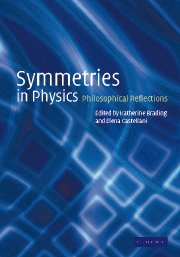Book contents
- Frontmatter
- Contents
- List of contributors
- Preface
- Copyright acknowledgements
- 1 Introduction
- Part I Continuous symmetries
- Part II Discrete symmetries
- Part III Symmetry breaking
- Part IV General interpretative issues
- 22 Classic texts: extracts from Wigner
- 23 Symmetry as a guide to superfluous theoretical structure
- 24 Notes on symmetries
- 25 Symmetry, objectivity, and design
- 26 Symmetry and equivalence
- Index
25 - Symmetry, objectivity, and design
Published online by Cambridge University Press: 08 October 2009
- Frontmatter
- Contents
- List of contributors
- Preface
- Copyright acknowledgements
- 1 Introduction
- Part I Continuous symmetries
- Part II Discrete symmetries
- Part III Symmetry breaking
- Part IV General interpretative issues
- 22 Classic texts: extracts from Wigner
- 23 Symmetry as a guide to superfluous theoretical structure
- 24 Notes on symmetries
- 25 Symmetry, objectivity, and design
- 26 Symmetry and equivalence
- Index
Summary
Introduction
Symmetry has an undeniable heuristic value in physics, as is demonstrated throughout this volume. To see if the value is more than instrumental, that is, to see if the symmetries are somehow in nature itself, we should ask a transcendental question: what must the world be like such that symmetry would be so effective in understanding it?
I will describe two apparent conditions of symmetry: objectivity and design. It will turn out that only one of these, objectivity, can be securely linked to symmetry. But symmetry does not serve as evidence for design in nature. In fact, the very aspects of symmetry that link it to objectivity suggest that it is not the result of design. The two apparent implications of symmetry are incompatible, and there is clear reason to retain the notion of objectivity and give up design.
Symmetry and objectivity
The accomplishment of knowledge involves keeping track of relations between the permanent and the ephemeral. Sensations keep changing while the relevant categories to describe them stay the same, and we have empirical knowledge of the world when we can accurately associate the fleeting sensations with their more permanent concepts. Coordinate systems remain fixed as an object's position changes, and the science of kinematics is useful insofar as it can describe the variable positions in terms of the stable reference frame. In general, knowledge is intimately involved in the interplay between what changes and what doesn't.
Information
- Type
- Chapter
- Information
- Symmetries in PhysicsPhilosophical Reflections, pp. 413 - 424Publisher: Cambridge University PressPrint publication year: 2003
Accessibility standard: Unknown
Why this information is here
This section outlines the accessibility features of this content - including support for screen readers, full keyboard navigation and high-contrast display options. This may not be relevant for you.Accessibility Information
- 4
- Cited by
